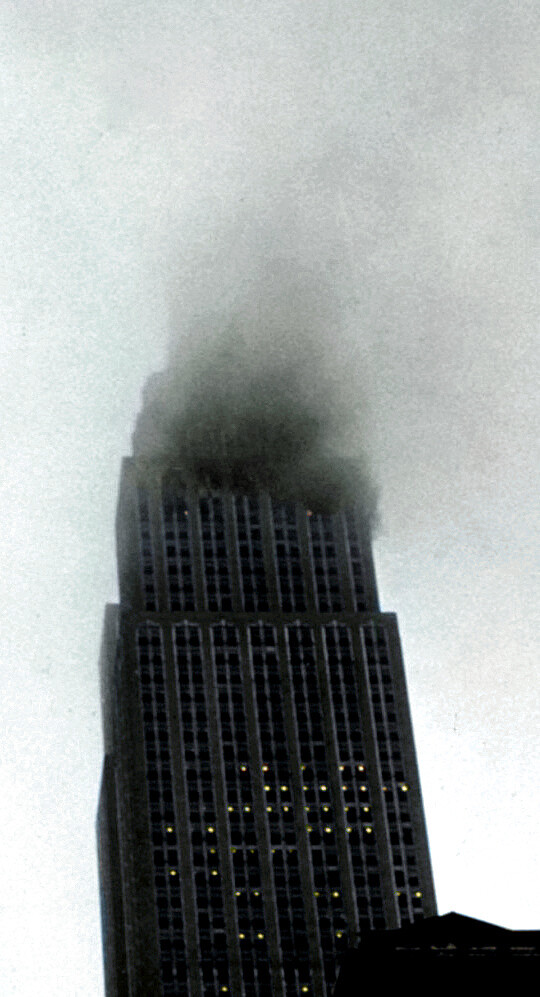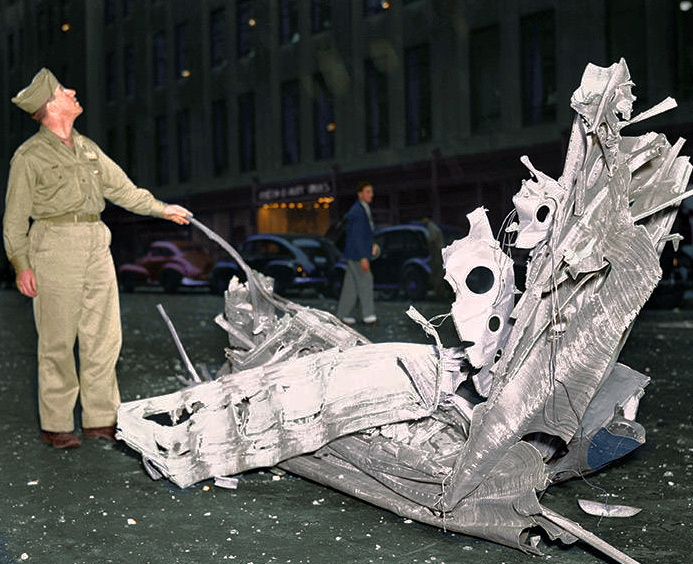The Pittsburgh Press (July 28, 1945)
B-25 hits Empire State; at least 13 die in building
Army pilot lost in fog; upper part becomes a blazing inferno
Billowing smoke and flame pour from the tower of the Empire State Building immediately after it was hit by a low-flying B-25 bomber today. The flames shot 300 feet in the air when the bomber smashed into the tower.
NEW YORK (UP) – A B-25 bomber crashed and exploded in the 78th floor of the Empire State Building today and the upper part of the tallest building in the world instantly became a blazing inferno for hundreds of office workers perched 1,000 feet above the street.
The plane was lost in a fog when it struck. It broke into a giant, spectacular burst of flame. The explosion rocked Midtown Manhattan.
Nearly four hours after the disaster. the death toll was in doubt. A police captain in the building said at 1:30 p.m. that 13 bodies had been found in the structure – 11 on the 79th floor, one on the 78th and one on the 72nd. Earlier, Police Headquarters said 19 had been killed.
Many of the bodies were so mangled that it may be days before the death list is completed. Of the 13 bodies, 12 were unidentified.
Flames raged out of control in six floors of the 102-story building for 40 minutes. Three elevators fell from the 80th floor to the ground. Glass and debris rained into the street.
The plane struck the north side of the building, penetrated a wing of the floor, destroyed everything in its path and went out the south wing of the building. Part of it landed on the roof of the 12-story Waldorf Building on 33rd Street.
Six of the dead were reported to be soldiers, some presumably members of the plane’s crew of five.
Only the fact that it was Saturday morning, when many offices are closed, prevented a far greater disaster.
The 78th floor was unoccupied. On the 79th floor, occupied by offices of the War Relief Service of the National Catholic Welfare Council, several persons were killed.
Nine bodies were reported found on the 79th floor. Three bodies were taken from two of the fallen elevators. The third was empty.
An enormous crowd gathered in the street and the largest amount of firefighting apparatus ever assembled in New York City was rushed out in four fire alarms.
Glass and debris continued to shower down for almost an hour.
Plane wreckage in street following the crash of a B-25 bomber into the side of the Empire State Building. Cpl. Harry A. Berger of the Bronx stands beside the wreckage straining to watch smoke and flames pouring from the giant structure. Base of the building is shown in the background.
The 34th Street foyer of the building was converted into an emergency receiving station.
Bellevue Hospital sent all available doctors, nurses and disaster equipment.
First reporters to fight their way up past the smoke-clouded 69th floor found the cowling of the plane still stuck to the side of the building. The point where the plane struck was near a bank of 10 elevators. All floors from the 69th to the 79th were littered with debris.
About 20 feet inside the window nearest where the plane struck lay one of the B-25s engines and half a propeller. A fragment of a propeller was imbedded in a wall.
Office windows were shattered 10 floors up and 10 floors below the 78th story. A stream of firemen, police, priests, doctors and nurses moved up and down the stairs. Six charred bodies lay in and near the Catholic Welfare offices.
Mayor F. H. LaGuardia, quickly at the scene, inspected the 78th floor and said: “It was just an oven.”
He said the plane was “flying too low.” City regulations forbid flying fewer than 5,000 feet over the city, he said.
Witnesses said the plane zoomed down Fifth Avenue, apparently in trouble.
Nanette Morrison, typist in the office of Carl Byor Associates publicists, was gazing out the window as the plane approached. Not realizing her peril at first, she leaned from the window and started to wave to the crew members, she said.
The Army said the bomber left Bedford, Massachusetts, on “contact flying regulations.” A control tower operator at the field said the ceiling was 1,100 feet over Manhattan at 9:50 a.m., the time of the crash.
The Empire State Building is 1,250 feet tall and on foggy days its peak usually is obscured.
One of the first dead to be identified was Paul Deering, 40, a reporter for The Buffalo Courier-Express. Mr. Deering’s body was recovered from a window ledge on the 72nd floor, and police believed he died trying to escape from an upper floor.
Roofs of several nearby buildings were set afire by the spray of blazing gasoline from the plane.
An enormous throng rushed to the scene and all available firefighting apparatus in the city was called.
Fog, at times closing in to 500 feet of the ground, blotted out the view of fire from the street at times.
Despite the fire, the lower floors of the building were not evacuated and heads could be seen protruding from windows up to the 20th floor.
Army Public Relations officers said the plane was en route from Bedford to LaGuardia Field. It was reported to have attempted to land at LaGuardia and to have turned and headed for Newark when low visibility prevented a landing here.
The first flash of flames swept through seven stories of the building, from the 79th to 86th floors.
Army Lt. Aubrey B. Condit, a pilot, was on the 55th floor of the building when the crash came. He said the plane that struck the tower was a B-25 Billy Mitchell bomber, which carried a crew of three.
Thousands of workers and residents in the Midtown area rushed to windows of surrounding buildings to watch the spectacular fire and the scurry of hundreds of firemen, and white-coated ambulance physicians in the street.
The crash came like a peal of thunder, and many of those who heard it dismissed it as such. The morning had been heavy with humidity and the skies were overcast.
When a mass of flames spewed out from the tower, observers first believed lightning had struck the building. Then reports flashed from the stricken skyscraper that a bomber had rammed the east side of the tower, exploded, and bounced off in flames to the roof of the old Waldorf Building.
At 10:30, the tower was still blazing, and firemen found a large tire from the plane on the Waldorf Building roof.
William Yates, elevator operator in the building, said he saw the plane blown back from the tower after it crashed. Yates was returning to the building from a barber shop.
The pilot was flying by contact with the ground rather than by instrument, although visibility over Manhattan was only about 500 feet.
Police and fire lines were formed several blocks from the building, and pedestrians elbowed and shoved on the edges, trying to force their way closer to the scene.
Ellen Lowe of Floral Park, New York, who works for the Catholic Welfare Council, said:
It was hell on earth. I was typing. Suddenly there was a blast and our whole office burst into flames. This was followed by thick, acrid smoke. We ran to the windows and hung out to get some air. As we did that. we saw smoke pouring out of the 76th floor. We prayed that the wind would divert the smoke and it did. occasionally, but once in a while, great blasts of it would come up to our floor.
A girl elevator operator was blown out of her elevator on the 75th floor and taken to the office of the Air Cargo Transport Corp. for treatment. The skin was literally peeled from her face.
Mayor LaGuardia said the bodies of the plane crew may have been destroyed, mangled or thrown from the building by the tremendous force of the crash.
Office windows were shattered 10 floors above and 10 floors below the 78th story. From the 76th floor up, stairways were a tangled mass of firehose.
Army, Navy and FBI officials rushed to investigate.

